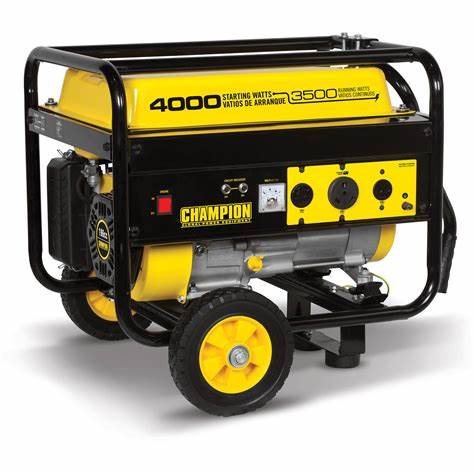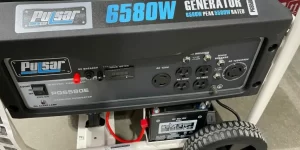Champion Generator Has a Gas Leak (Troubleshoot)
If you notice a puddle of gas or intense gas odors emanating from your generator, you likely have a fuel leak. I’ve provided a checklist that you can use to pinpoint the source of the leak.
A damaged carburetor bowl gasket or trapped float might cause gas to leak from the carburetor of a Champion generator. It could potentially seep out of the fuel shutoff valve, the fuel tank, the fuel lines, or the fuel filter.
Keep the generator in a cool, well-ventilated place at all times. Take the necessary precautions as outlined in your Champion’s manual.
 Before diagnosing, repairing, or operating, be sure you’ve read and understood all of the safety recommendations in the equipment’s operator’s manual.If you are unsure about how to proceed or if you lack the necessary expertise or experience, you should seek the assistance of a professional.
Before diagnosing, repairing, or operating, be sure you’ve read and understood all of the safety recommendations in the equipment’s operator’s manual.If you are unsure about how to proceed or if you lack the necessary expertise or experience, you should seek the assistance of a professional.
Table of Contents
A Champion Generator has a Gas Leak Here
The Champion Generator’s Carburetor
After leaving the fuel tank, some gasoline is held in the carburetor. The varnish produced by the gas resting in the carburetor might cause the tiny moving parts to become stuck, rendering the carburetor unable to control the flow of gasoline. As a result, it may begin to overflow.
The carburetor bowl gasket can also fail, leading to a leak, in addition to any malfunctioning internal parts.
The carburetor bowl gasket on Champion generator blew.
Start by inspecting the carburetor’s bowl attachment. A thin, rubber-like gasket connects the carburetor to the bowl.
The gasket acts as a seal between the two parts, preventing gas from escaping. When it stops sealing, gas will leak out.
This gasket often gets hard and brittle after some time. Since the gasket is so close to the engine, its temperature rises when the engine is in operation and falls when it is turned off.
The gasket was unable to maintain its seal because of the repeated stress of being heated and then cooled. A replacement carburetor bowl gasket should be purchased and installed if a leak is discovered here.
How to substitute the carburetor bowl gasket:
- Turn off the fuel valve to stop the flow of fuel. If your generator doesn’t have a fuel valve, you can crimp the fuel line with a pair of pinch pliers to halt the flow.
- Before removing the bowl, make sure the carburetor’s exterior is clean so that debris doesn’t get sucked into the engine.
- Keep a towel or other small receptacle handy to wipe out the bowl and save any remaining gasoline.
- There may be a screw on the side of the gasoline bowl that can be used to empty the carburetor. If that’s the case, unscrew it, catch the fuel in a container, and reinstall the screw. If not, then move on to the following section.
- Take off the bowl of the carburetor by unscrewing it.
- Get rid of the old gasket and swap it out for the new one.
- Put the carburetor bowl back in place.
- Put the screw back in the bowl’s carburetor.
- If there was any fuel spillage, clean the carburetor once more.
- Check for further leakage from the carburetor after turning on the gasoline supply.
Champion generator float stuck in the carburetor
Next, inspect the area around the air intake port for gasoline leaks. If you discover a leak here, it may be because the float has become stuck and is no longer able to control the amount of fuel entering the bowl.
With a jammed float, fuel continues to pour into the carburetor bowl and eventually spills out.
When you discover a stuck float, you need to disassemble your carburetor to find out why. If the float keeps getting stuck, try cleaning the carburetor.
The carburetor may need to be rebuilt or replaced before it can function properly again.
Champion generator carburetor float needle jammed
The float needle in your carburetor should be the final item you inspect. Together, the float and the float needle maintain gas flow to the carburetor bowl. The needle will need to be fixed if it becomes jammed.
You can either disassemble your carburetor and replace the float yourself, or take it to a small engine specialist.
Champion Generator Fuel Filter Is Cracked Or Soggy
Next, if your model generator has an inline plastic fuel filter, inspect that. The fuel filter (on many Champion generators) is either at the bottom of the fuel tank or is a thin filter installed into a gasoline component that is difficult to reach.
Gas leaks can occur if the plastic housing is damaged in any way, especially if the plastic has grown soft.
In time, gas can degrade polymers. The fuel filter might grow brittle and leak around the edges if it isn’t changed regularly.
If your filter has a fracture or is made of flimsy plastic, it will leak and will need to be replaced.
Care must be used when disconnecting the inline filter from the gasoline lines. The fuel lines are vulnerable to damage from the brittle plastic.
Your Champion Generator’s Gas Tank Has Leaked
The fuel tank of your Champion generator could be made of metal or HDPE. Both types are equally susceptible to leaking as they get older.
- Polyethylene storage tanks have a tendency to leak at the seams.
- Fuel left in a metal tank can rust and eventually eat a hole in the container.
If you discover a fuel tank leak, you should get a new one as soon as possible.
However, you might not have this choice if your vehicle has a metal tank and is an older model that is no longer produced. You can try to fix the hole, but first you need to get rid of the rust.
The Champion Generator’s Safety Valve Is Broken
The fuel shut-off valve often develops a leak. Your Champion generator’s valve, whether it’s constructed of plastic or metal, will eventually leak.
When the seal between the sediment bowl and the shut-off valve weakens, leaks might form. Fix the gasoline shutoff valve that has failed. It is possible to fix the leak by replacing the seal in the sediment bowl.
Champion Generator Fuel Lines
Dry and brittle is what time does to fuel lines. Over time, fuel will begin to leak out of the cracks. Repairing a fuel line is not an option if it has a crack.
Make that the hose is properly attached to the fuel system components and that there is no fuel leaking out.







